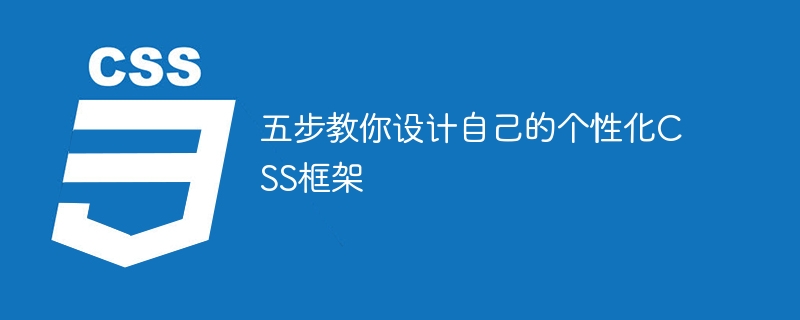Home >Web Front-end >CSS Tutorial >Simple Guide: Create a personalized CSS framework in just five steps
Simple Guide: Create a personalized CSS framework in just five steps
- PHPzOriginal
- 2024-01-05 16:31:041398browse

Five steps to teach you to design your own personalized CSS framework
Introduction:
In modern web development, CSS frameworks are widely used to quickly build websites and The application's interface. However, most CSS frameworks are generic and cannot meet the unique needs of every project. Designing a personalized CSS framework can help us better control the appearance and style of the website and improve development efficiency. Below, I will share five steps to teach you how to design your own personalized CSS framework.
Step 1: Define basic styles
Before designing a personalized CSS framework, we first need to define a set of basic styles. These basic styles should include resetting default styles, setting fonts, colors, line heights and other common styles. To facilitate subsequent maintenance and expansion, you can use CSS preprocessors (such as Less and Sass) to define these basic styles.
Sample code:
/* 重置默认样式 */
body, h1, p {
margin: 0;
padding: 0;
}
/* 设置字体和颜色 */
body {
font-family: Arial, sans-serif;
color: #333;
}
h1 {
font-size: 24px;
color: #000;
}
p {
font-size: 16px;
}
Step 2: Build a grid system
A good grid system can help us better layout web pages and applications. When designing a personalized CSS framework, we can build a suitable grid system according to the needs of the project. Common grid systems include grids, columns, and containers.
Sample code:
/* 栅格系统样式 */
.container {
width: 100%;
}
.row {
display: flex;
flex-wrap: wrap;
}
.column {
flex: 1;
padding: 10px;
}
/* 栏目样式 */
.column-1 {
width: 8.33%;
}
.column-2 {
width: 16.67%;
}
.column-3 {
width: 25%;
}
...
Step 3: Define component styles
When designing a personalized CSS framework, we can also define some commonly used component styles for reuse in development . These component styles can include buttons, forms, navigation, breadcrumbs, etc.
Sample code:
/* 按钮样式 */
.button {
display: inline-block;
padding: 10px 20px;
border: none;
cursor: pointer;
}
.button-primary {
background-color: #007bff;
color: #fff;
}
.button-secondary {
background-color: #6c757d;
color: #fff;
}
/* 表单样式 */
.form-group {
margin-bottom: 10px;
}
.input {
padding: 5px 10px;
border: 1px solid #ccc;
}
/* 导航样式 */
.nav {
list-style: none;
display: flex;
}
.nav-item {
margin-right: 10px;
}
/* 面包屑样式 */
.breadcrumb {
list-style: none;
display: flex;
}
.breadcrumb-item {
margin-right: 5px;
cursor: pointer;
}
.breadcrumb-item:hover {
text-decoration: underline;
}
Step 4: Customize theme styles
The personalized CSS framework should allow users to customize theme styles according to project needs. We can add some configurable variables to the framework, such as theme color, background color and font, etc. By modifying the values of these variables, we can easily customize the look and feel of the entire framework.
Sample code:
/* 主题变量 */
@theme-color: #007bff;
@theme-background-color: #f5f5f5;
@theme-font: Arial, sans-serif;
/* 按钮样式 */
.button-primary {
background-color: @theme-color;
color: #fff;
}
/* 背景颜色 */
body {
background-color: @theme-background-color;
}
/* 字体 */
body {
font-family: @theme-font;
}
Step 5: Write documentation and sample code
In order to facilitate other developers to use the personalized CSS framework you designed, you need to write detailed documentation and sample code . Documentation should include framework usage, style naming conventions, configurable variables, etc.
Sample code:
/*
文档: 我的个性化CSS框架
用法:
1. 在HTML文件中引入框架的CSS文件
2. 使用框架提供的样式类来定义网页的外观和布局
3. 可以根据需要修改框架的变量来定制主题
样式命名约定:
• 使用中划线连接单词(例如:button-primary、form-group)
• 使用统一的命名规范,方便后续的维护
*/
/* 示例代码 */
<div class="container">
<div class="row">
<div class="column column-3">
<form class="form-group">
<input type="text" class="input" placeholder="请输入...">
</form>
</div>
<div class="column column-9">
<ul class="nav">
<li class="nav-item">首页</li>
<li class="nav-item">关于</li>
<li class="nav-item">联系我们</li>
</ul>
</div>
</div>
</div>
Conclusion:
Through the above five steps, we can design a personalized and easy-to-use CSS framework to meet the unique needs of the project. By properly defining basic styles, building grid systems, defining component styles, customizing theme styles, and writing documentation and sample code, we can improve development efficiency while also better controlling the appearance and style of the website. I hope this tutorial will be helpful to your CSS framework design!
The above is the detailed content of Simple Guide: Create a personalized CSS framework in just five steps. For more information, please follow other related articles on the PHP Chinese website!

